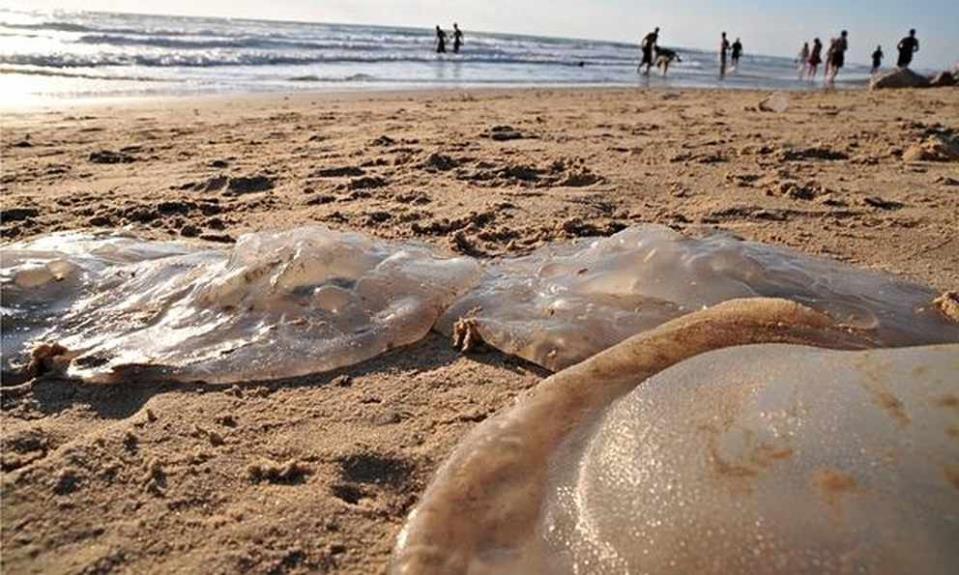Adds comments by marine biologist Alan Deidun.
A species of jellyfish “that can weigh up to 50 kg” (but which according to some websites can only reach 10kg in weight) and has a very painful sting has already been spotted near Malta and Tunisia and could soon visit Italy’s shores, according to a report in an Italian news website.
Italian news agency Ansa and newspaper La Repubblica have reported the news. The Blitz Quotidiano says that the Nomadic Jellyfish has already caused problems to tourism in Israel, where it also clogged water desalination plants.
The Rhopilema Nomadica is indigenous to the tropical warm waters of Indian and Pacific Oceans but has been since in the Eastern Mediterranean sea since the 1970s, having entered from the Suez Canal. The European Union lists the species – with a light blue coloured body that can grow up to half a metre in length – as one of the worst invasive marine species in European waters.

“Massive swarms stretching more than 100km appear along the Levant coast every summer. These swarms of voracious planktotrophs must play havoc with the limited resources of the oligotrophic Mediterranean Sea. Health and Social Impacts Local municipalities in Israel have reported a decrease in holiday-makers frequenting the beaches because of the public’s concern over the painful stings inflicted by the jellyfish,” according to europe-aliens.org.
"When the shoals draw nearer shore, they adversely affect tourism, fisheries and coastal installations. Coastal trawling and purse-seine fishing are disrupted for the duration of the swarming due to net clogging and inability to sort yield, due to the overwhelming presence of these venomous medusas in the nets. Jellyfish-blocked water intake pipes pose a threat to cooling systems of port-bound vessels and coastal power plants.” The website says, however, that the jellyfish can grow up to 10kg in size, not 50kg.
The Italian news report says the species has moved further west into the Mediterranean because of the recent expansion of the Suez Canal and the high temperatures in the region. It quotes scientist Fernando Boero, from CNR-Ismar, said that for the introduction of species from the Red Sea has become more common in the last thirty years. He is one of around 500 scientists from 40 countries that have written to the Egyptian authorities asking them to evaluate the environmental impact of the Suez Canal restyling. The project is set to be inaugurated later on this week but no environmental impact assessment has been carried out, according to the report.
The report also quotes European Commissioner Karmenu Vella as saying that the Commission is well aware that the enlargement of the Suez Canal could lead to the introduction of a number of invasive species into the Mediterranean.

His spokesperson, Enrico Brivio, said these concerns have been passed on to Cairo but no studies have been presented to the EC.
One of the proposals being put forward is for the establishment of monitoring stations near Suez, which could serve as an early warning. Bella Galil from the Israel Oceanographic Institute says that the absence of interventions to reduce the biological invasion would result in the deterioration of biodiversity, the destruction of some valuable habitats and the services they provide. "When the first swarm of Rhopilema arrives in Sicily, it will be too late," says Galil.

‘No cause for alarm’ – Alan Deidun
Contacted by this newsroom, marine biologist Alan Deidun said there have been no recent reports of nomadic in Maltese waters. “There were only a couple of sightings around the year 2006 but, luckily, these were individual jellyfish, not blooms.” Professor Deidun said that there were reports, however, of nomadic jellyfish blooms in and around Tunisian waters last year. This could have a deep economic impact on the country, he said, as nomadic jellyfish cause problems to the tourism, fishing and energy sectors.
Professor Deidun played down the Italian media reports which, he said, can often be sensational. “They probably said there were nomadic jellyfish in Malta because they read existing literature on the species, but the truth is that we have never experienced nomadic jellyfish blooms over here. Such claims need to be backed up with photographs.” The marine biologist said that the recent reports from Tunisia, which have been confirmed, were still no cause for alarm. “This species is still very rare in this side of the Mediterranean. And I believe that the strong currents found around Malta will act as a sort of defensive barrier, protecting us.”
He said, however, that anyone encountering the species should make use of the Spot the Jellyfish website.